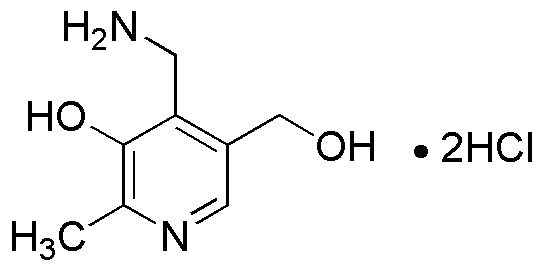Pyridoxamine dihydrochloride is widely utilized in research focused on:
- Dietary Supplements: Commonly used as a vitamin B6 supplement, it supports metabolic processes and helps maintain healthy nerve function.
- Diabetes Management: Research indicates its potential in reducing advanced glycation end-products (AGEs), which are linked to diabetes complications, making it beneficial for diabetic patients.
- Cardiovascular Health: Studies suggest that it may help lower homocysteine levels, a risk factor for heart disease, thus contributing to improved heart health.
- Neurological Research: Its neuroprotective properties are being explored for potential applications in treating neurodegenerative diseases, offering hope for conditions like Alzheimer's.
- Skin Care Products: Increasingly incorporated into formulations for its antioxidant properties, it helps protect skin from oxidative stress and supports overall skin health.
General Information
Properties
Safety and Regulations
Applications
Pyridoxamine dihydrochloride is widely utilized in research focused on:
- Dietary Supplements: Commonly used as a vitamin B6 supplement, it supports metabolic processes and helps maintain healthy nerve function.
- Diabetes Management: Research indicates its potential in reducing advanced glycation end-products (AGEs), which are linked to diabetes complications, making it beneficial for diabetic patients.
- Cardiovascular Health: Studies suggest that it may help lower homocysteine levels, a risk factor for heart disease, thus contributing to improved heart health.
- Neurological Research: Its neuroprotective properties are being explored for potential applications in treating neurodegenerative diseases, offering hope for conditions like Alzheimer's.
- Skin Care Products: Increasingly incorporated into formulations for its antioxidant properties, it helps protect skin from oxidative stress and supports overall skin health.
Documents
Safety Data Sheets (SDS)
The SDS provides comprehensive safety information on handling, storage, and disposal of the product.
Product Specification (PS)
The PS provides a comprehensive breakdown of the product’s properties, including chemical composition, physical state, purity, and storage requirements. It also details acceptable quality ranges and the product's intended applications.
Certificates of Analysis (COA)
Search for Certificates of Analysis (COA) by entering the products Lot Number. Lot and Batch Numbers can be found on a product’s label following the words ‘Lot’ or ‘Batch’.
*Catalog Number
*Lot Number
Certificates Of Origin (COO)
This COO confirms the country where the product was manufactured, and also details the materials and components used in it and whether it is derived from natural, synthetic, or other specific sources. This certificate may be required for customs, trade, and regulatory compliance.
*Catalog Number
*Lot Number
Safety Data Sheets (SDS)
The SDS provides comprehensive safety information on handling, storage, and disposal of the product.
DownloadProduct Specification (PS)
The PS provides a comprehensive breakdown of the product’s properties, including chemical composition, physical state, purity, and storage requirements. It also details acceptable quality ranges and the product's intended applications.
DownloadCertificates of Analysis (COA)
Search for Certificates of Analysis (COA) by entering the products Lot Number. Lot and Batch Numbers can be found on a product’s label following the words ‘Lot’ or ‘Batch’.
*Catalog Number
*Lot Number
Certificates Of Origin (COO)
This COO confirms the country where the product was manufactured, and also details the materials and components used in it and whether it is derived from natural, synthetic, or other specific sources. This certificate may be required for customs, trade, and regulatory compliance.


